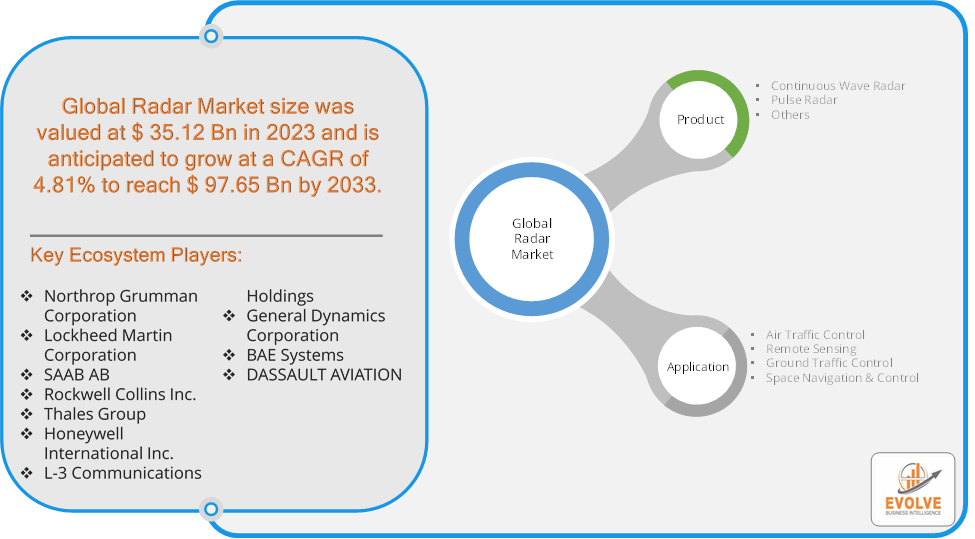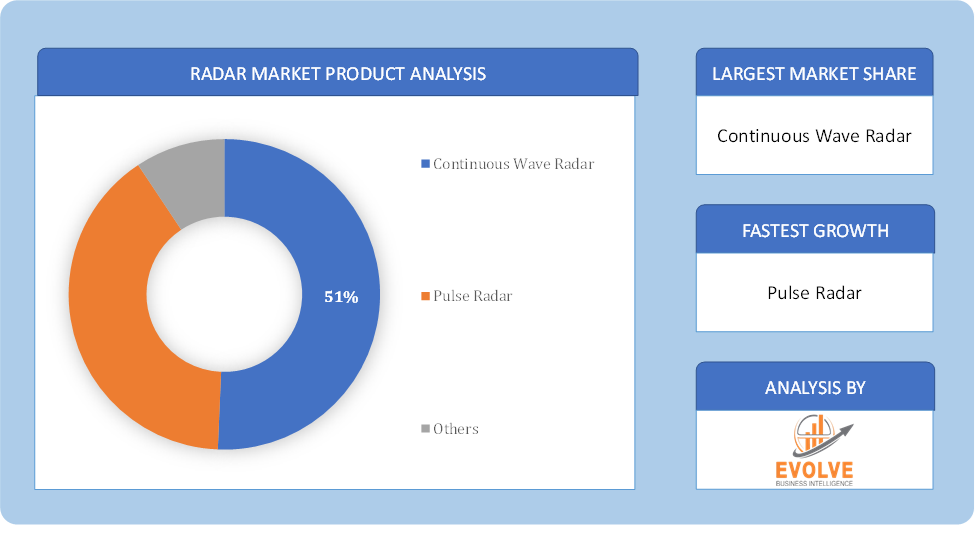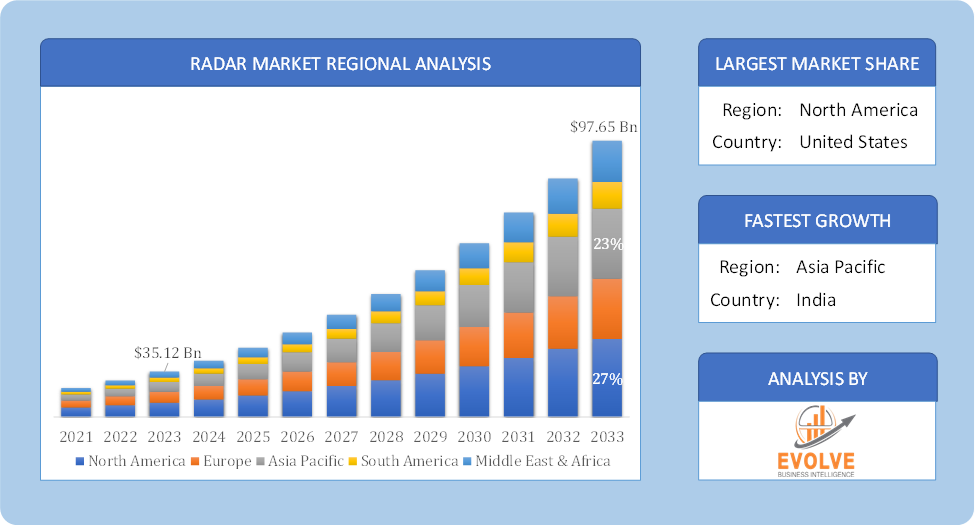Radar Market Overview
The Radar Market Size is expected to reach USD 97.65 Billion by 2033. The Radar industry size accounted for USD 35.12 Billion in 2023 and is expected to expand at a compound annual growth rate (CAGR) of 4.81% from 2023 to 2033. The radar market encompasses technologies and systems used to detect, track, and analyze objects or phenomena through radio waves. It includes various radar types, such as weather radar, automotive radar, maritime radar, and defense radar. Key applications span across defense and military, aviation, automotive, and industrial sectors. The market is driven by advancements in technology, increasing security and defense needs, and growing demand for enhanced navigation and collision avoidance systems. Innovations like phased-array and synthetic aperture radars are pushing market growth, while regulatory standards and technological integration challenges can impact development.
Global Radar Market Synopsis
The COVID-19 pandemic has led to supply chain disruptions leading to supply shortages or lower demand in the Radar market. The travel restrictions and social-distancing measures have resulted in a sharp drop in consumer and business spending and this pattern is to continue for some time. The end-user trend and preferences have changed due to the pandemic and have resulted in manufacturers, developers, and service providers to adopt various strategies to stabilize the company.
Radar Market Dynamics
The major factors that have impacted the growth of Radar are as follows:
Drivers:
Ø Technological Advancements
Continuous improvements in radar technology, such as higher resolution, improved detection capabilities, and miniaturization of radar systems, have expanded their applications. Advances like phased-array radars and synthetic aperture radars (SAR) are making radar systems more versatile and effective
Restraint:
- Technological Complexity
Integrating advanced radar systems with existing infrastructure or other technologies can be complex and require specialized knowledge and skills. This complexity can delay deployment and increase costs. The rapid pace of technological advancements means that radar systems can become obsolete quickly. Keeping up with technological changes and ensuring compatibility with newer systems can be challenging.
Opportunity:
⮚ Technological Advancements and Innovations
Integrating radar technology with artificial intelligence (AI) and machine learning enhances data processing, analysis, and decision-making capabilities. This integration enables more advanced features such as real-time object classification, predictive analytics, and improved accuracy, creating new opportunities for radar applications.
Radar Market Segment Overview
Based on Product Type, the market is segmented based on Continuous Wave Radar, Pulse Radar, Others. Pulse Radar dominates, primarily due to its wide application in aviation, weather monitoring, and defense for its ability to provide high-resolution and long-range detection.
By Application
Based on Applications, the market has been divided into the Air Traffic Control, Remote Sensing, Ground Traffic Control, Space Navigation & Control. the Air Traffic Control segment dominates, driven by the critical need for advanced radar systems to manage and ensure the safety of increasingly congested airspace.
Global Radar Market Regional Analysis
Based on region, the global Radar Market has been divided into North America, Europe, Asia-Pacific, the Middle East & Africa, and Latin America. Europe is projected to dominate the use of the Radar Market followed by the Asia-Pacific and Europe regions.
 Radar Europe Market
Radar Europe Market
Europe holds a dominant position in the Radar Market. Due to the region’s robust military and defense infrastructure, which will fuel market expansion, the Europe radar sensors market area will dominate this one.
Radar Asia-Pacific Market
The Asia-Pacific region has indeed emerged as the fastest-growing market for the Radar industry. The radar sensor market in Asia-Pacific is anticipated to expand at the quickest rate possible between 2023 and 2032.due to the Region’s rapidly expanding needs for consumer electronics, industrial automation, robotics, cellphones, and the automobile industry. In addition, the radar sensor market in China had the most market share, while the market in India had the quickest rate of growth in the Asia-Pacific area.
Competitive Landscape
The global Radar market is highly competitive, with numerous players offering a wide range of software solutions. The competitive landscape is characterized by the presence of established companies, as well as emerging startups and niche players. To increase their market position and attract a wide consumer base, the businesses are employing various strategies, such as product launches, and strategic alliances.
Prominent Players:
- Northrop Grumman Corporation
- Lockheed Martin Corporation
- SAAB AB
- Rockwell Collins Inc.
- Thales Group
- Honeywell International Inc.
- L-3 Communications Holdings
- General Dynamics Corporation
- BAE Systems
- DASSAULT AVIATION.
Key Development
In September 2022, BAE Systems announced the successful demonstration of its advanced radar technology for the Eurofighter Typhoon aircraft, showcasing improvements in tracking and targeting capabilities.
Scope of the Report
Global Radar Market, by Product
- Continuous Wave Radar
- Pulse Radar
- Others
Global Radar Market, by Application
- Air Traffic Control
- Remote Sensing
- Ground Traffic Control
- Space Navigation & Control
Global Radar Market, by Region
- North America
- US
- Canada
- Mexico
- Europe
- UK
- Germany
- France
- Italy
- Spain
- Benelux
- Nordic
- Rest of Europe
- Asia Pacific
- China
- Japan
- South Korea
- Indonesia
- Austalia
- Malaysia
- India
- Rest of Asia Pacific
- South America
- Brazil
- Argentina
- Rest of South America
- Middle East & Africa
- Saudi Arabia
- UAE
- Egypt
- South Africa
- Rest of Middle East & Africa
| Parameters | Indicators |
|---|---|
| Market Size | 2033: USD 97.65 Billion |
| CAGR (2023-2033) | 4.81% |
| Base year | 2022 |
| Forecast Period | 2023-2033 |
| Historical Data | 2021 (2017 to 2020 On Demand) |
| Report Coverage | Revenue Forecast, Competitive Landscape, Growth Factors, and Trends |
| Key Segmentations | Product Type, Application |
| Geographies Covered | North America, Europe, Asia-Pacific, South America, Middle East, Africa |
| Key Vendors | Northrop Grumman Corporation, Lockheed Martin Corporation, SAAB AB, Rockwell Collins Inc., Thales Group, Honeywell International Inc., L-3 Communications Holdings, General Dynamics Corporation, BAE Systems, DASSAULT AVIATION. |
| Key Market Opportunities | · The rising new emphasis on safety and security requirements in automotive applications |
| Key Market Drivers | · Identify and navigate other vehicles with the help of sensing direction and range of the sub-millimeter-wave radar sensors. |
REPORT CONTENT BRIEF:
- High-level analysis of the current and future Radar Market trends and opportunities
- Detailed analysis of current market drivers, restraining factors, and opportunities in the future
- Radar Market historical market size for the year 2021, and forecast from 2023 to 2033
- Radar Market share analysis at each product level
- Competitor analysis with detailed insight into its product segment, Government & Defense strength, and strategies adopted.
- Identifies key strategies adopted including product launches and developments, mergers and acquisitions, joint ventures, collaborations, and partnerships as well as funding taken and investment done, among others.
- To identify and understand the various factors involved in the global Radar Market affected by the pandemic
- To provide a detailed insight into the major companies operating in the market. The profiling will include the Government & Defense health of the company’s past 2-3 years with segmental and regional revenue breakup, product offering, recent developments, SWOT analysis, and key strategies.








